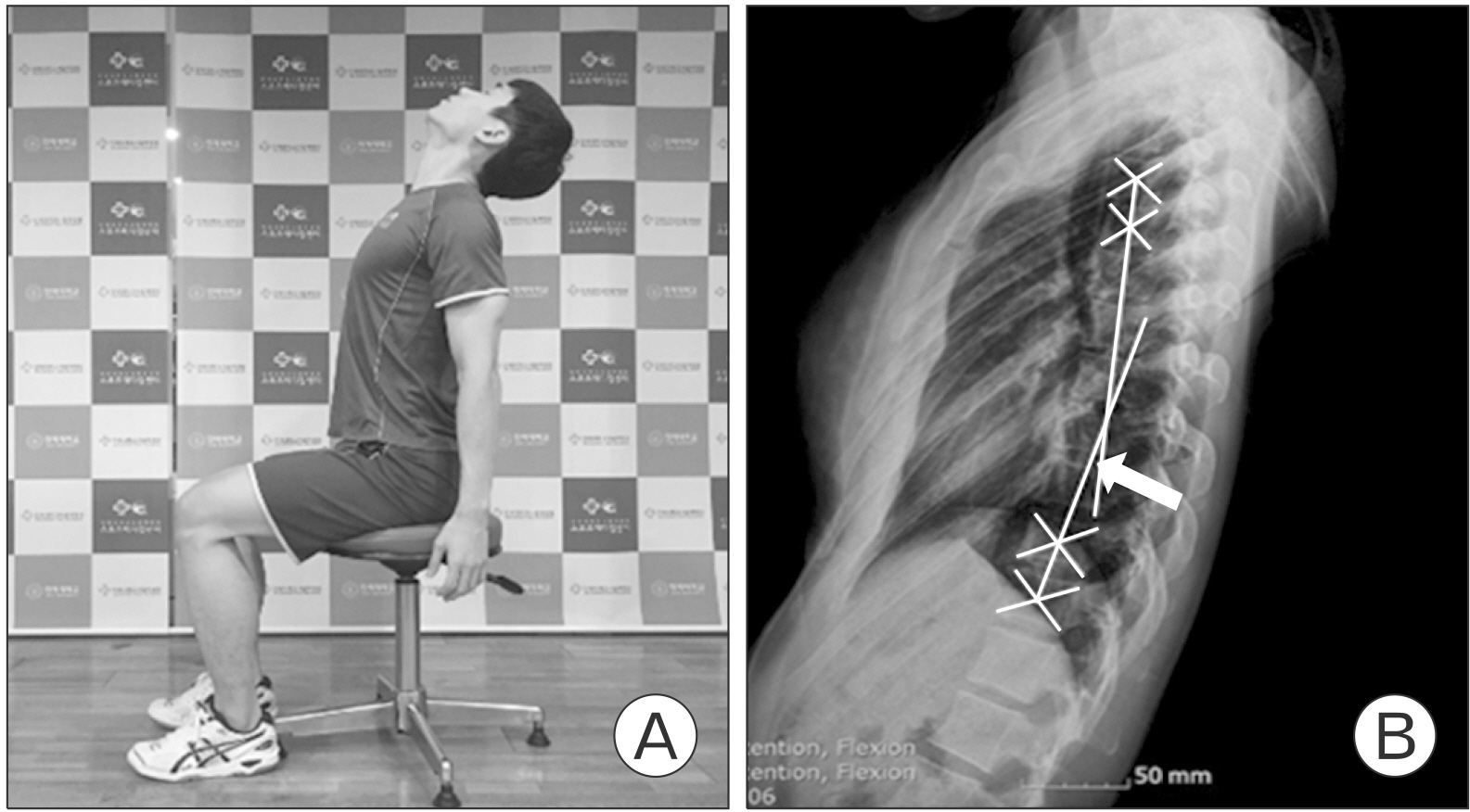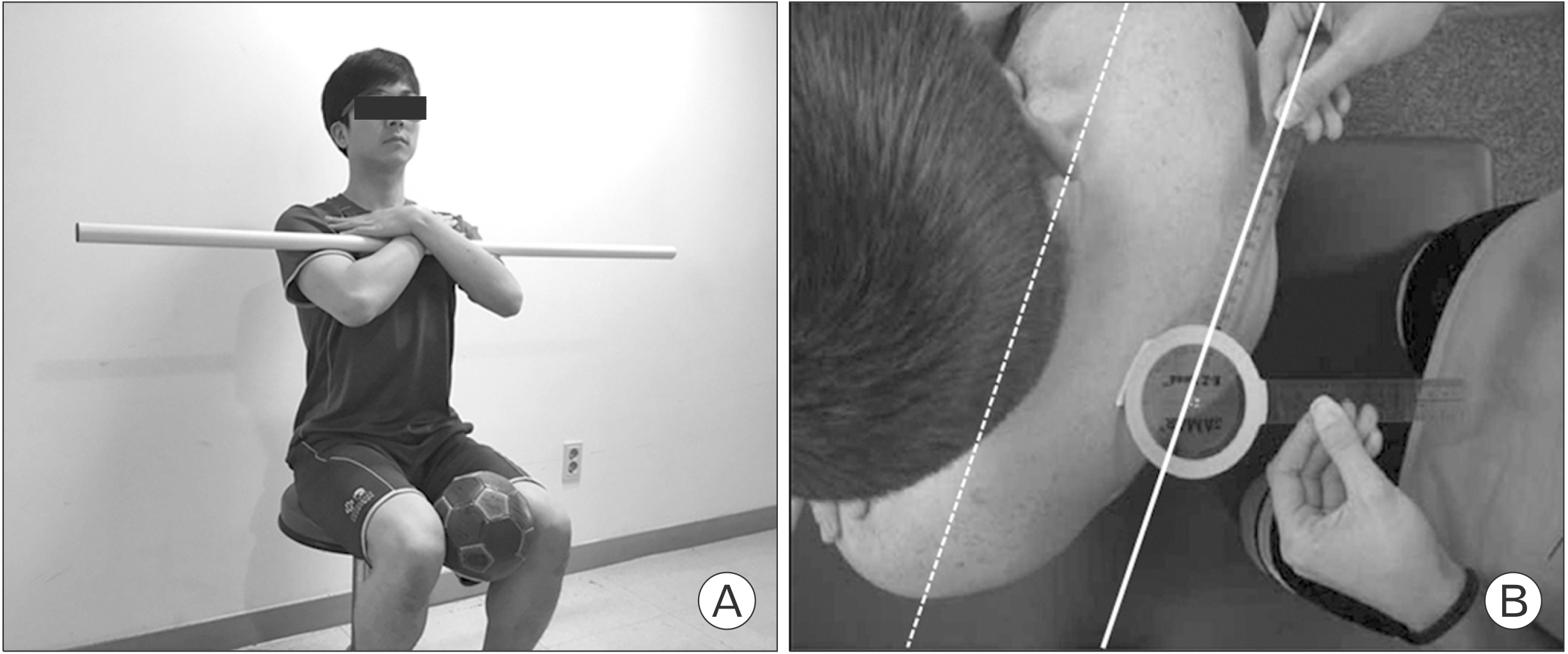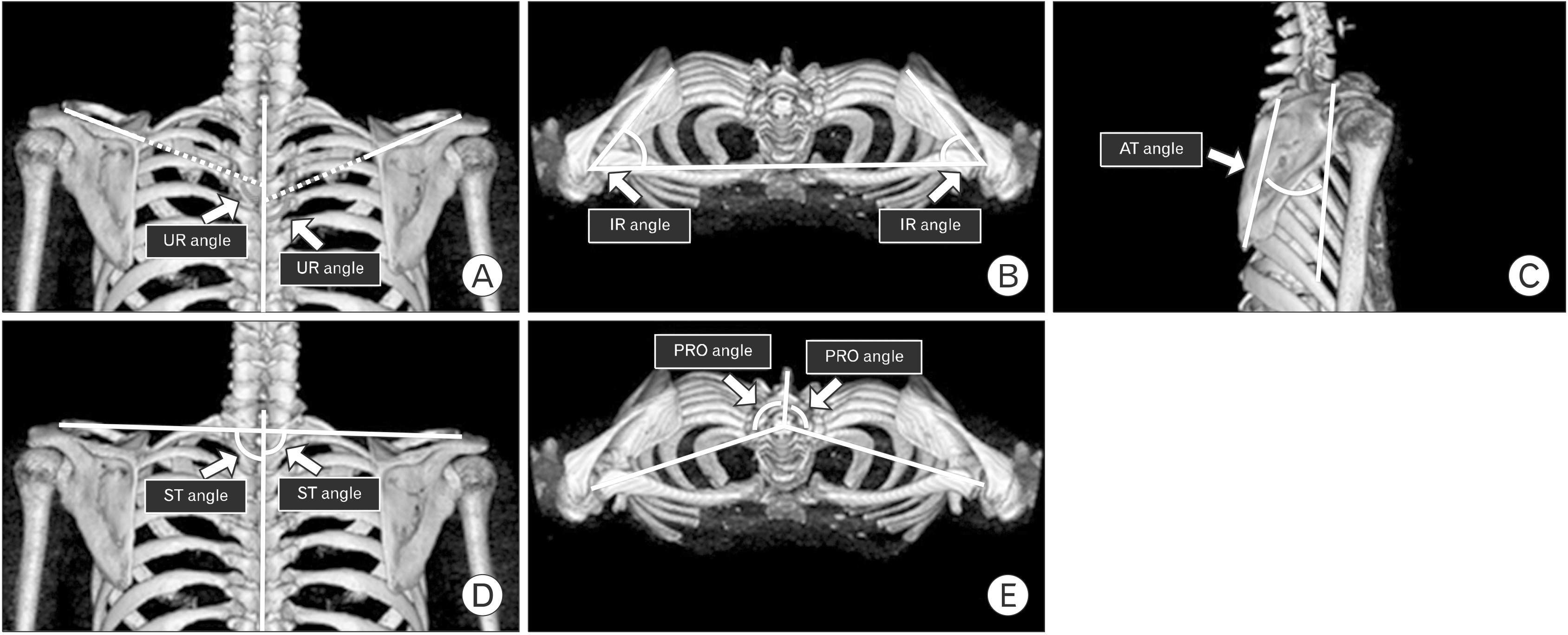Korean J Sports Med.
2022 Mar;40(1):12-21. 10.5763/kjsm.2022.40.1.12.
Effects of Thoracic Spine Mobility Exercise on Symptom Improvement and Scapular Position in Patient with Subacromial Impingement Syndrome
- Affiliations
-
- 1Department of Orthopedic Surgery and Sports Medical Center, Seoul Paik Hospital, Seoul, Korea
- 2Sports Medical Research Institute, Inje University, Seoul, Korea
- KMID: 2526684
- DOI: http://doi.org/10.5763/kjsm.2022.40.1.12
Abstract
- Purpose
The purpose of this study was to identify effects of the thoracic spine mobility exercise in patients with subacromial impingement syndrome (SIS).
Methods
Twenty patients diagnosed with SIS were selected and randomized into the combination exercise (CE) group (n=10) and shoulder exercise (SE) group (n=10). Both groups performed the same SE program for 12 weeks, and CE group performed the thoracic spine mobility exercises additionally. Before and after the exercises, visual analogue scale (VAS), shoulder range of motion (ROM), thoracic spine mobility, American Shoulder and Elbow Surgeons Shoulder Score (ASES) and Constant score, isokinetic strength, and scapula position were assessed.
Results
After 12 weeks of exercise intervention, there were significant improvements in VAS, thoracic spine mobility, ASES, isokinetic shoulder external rotation, and abduction strength in the CE group (p< 0.05). However, there were no significant interaction effects between the groups in shoulder ROM, Constant score, isokinetic shoulder internal rotation, and adduction strength. With scapular position, the internal rotation, anterior tilting, and protraction angles were significantly decreased after thoracic spine mobility exercise in the CE group (p< 0.05).
Conclusion
The symptoms and scapular positions of patients with SIS showed more improvement when the thoracic spine mobility exercises were performed in combination with shoulder exercises compared to shoulder exercises only.
Figure
Reference
-
1. Neer CS 2nd. 2005; Anterior acromioplasty for the chronic impingement syndrome in the shoulder. 1972. J Bone Joint Surg Am. 87:1399. DOI: 10.2106/00004623-200506000-00031. PMID: 15930554.
Article2. Kibler WB, McMullen J. 2003; Scapular dyskinesis and its relation to shoulder pain. J Am Acad Orthop Surg. 11:142–51. DOI: 10.5435/00124635-200303000-00008. PMID: 12670140.
Article3. McCreary EK, Provance PG, Rodgers MM, Romani WA. 1993. Muscles, testing and function: with posture and pain. Williams & Wilkins Baltimore;Baltimore (MD):4. Mottram SL. 1997; Dynamic stability of the scapula. Man Ther. 2:123–31. DOI: 10.1054/math.1997.0292. PMID: 11440525.
Article5. Thigpen CA, Padua DA, Michener LA, et al. 2010; Head and shoulder posture affect scapular mechanics and muscle activity in overhead tasks. J Electromyogr Kinesiol. 20:701–9. DOI: 10.1016/j.jelekin.2009.12.003. PMID: 20097090.
Article6. Boyles RE, Ritland BM, Miracle BM, et al. 2009; The short-term effects of thoracic spine thrust manipulation on patients with shoulder impingement syndrome. Man Ther. 14:375–80. DOI: 10.1016/j.math.2008.05.005. PMID: 18703377.
Article7. Kardouni JR, Shaffer SW, Pidcoe PE, Finucane SD, Cheatham SA, Michener LA. 2015; Immediate changes in pressure pain sensitivity after thoracic spinal manipulative therapy in patients with subacromial impingement syndrome: a randomized controlled study. Man Ther. 20:540–6. DOI: 10.1016/j.math.2014.12.003. PMID: 25595413.
Article8. Riley SP, Cote MP, Leger RR, et al. 2015; Short-term effects of thoracic spinal manipulations and message conveyed by clinicians to patients with musculoskeletal shoulder symptoms: a randomized clinical trial. J Man Manip Ther. 23:3–11. DOI: 10.1179/2042618613Y.0000000066. PMID: 26309376. PMCID: PMC4459141.
Article9. Yang YA, Kim YH, Kim YK, Hur JG, Song JC, Kim YS. 2004; Effects of thoracic spinal exercise program in VDT workers: pain relief and increased flexibility. Korean J Occup Environ Med. 16:250–61. DOI: 10.35371/kjoem.2004.16.3.250.
Article10. Evjenth O, Hamberg J. Autostretching: the complete manual of specific stretching. Alfta, Sweden: Rehab Förlag;2001.11. Neumann D. Neumann D, editor. Hip. Kinesiology of the musculoskeletal system: foundations for physical rehabilitation. St. Louis (MO): Mosby;2002. p. 387–433.12. Sahrmann S. Diagnosis and treatment of movement impairment syndromes. Elsevier Health Sciences;2001.13. Keegan JJ. 1953; Alterations of the lumbar curve related to posture and seating. J Bone Joint Surg Am. 35-A:589–603. DOI: 10.2106/00004623-195335030-00007. PMID: 13069548.
Article14. Ellenbecker TS, Cools A. 2010; Rehabilitation of shoulder impingement syndrome and rotator cuff injuries: an evidence-based review. Br J Sports Med. 44:319–27. DOI: 10.1136/bjsm.2009.058875. PMID: 20371557.
Article15. Kibler WB, Sciascia AD, Uhl TL, Tambay N, Cunningham T. 2008; Electromyographic analysis of specific exercises for scapular control in early phases of shoulder rehabilitation. Am J Sports Med. 36:1789–98. DOI: 10.1177/0363546508316281. PMID: 18469224.
Article16. Karvonen J, Vuorimaa T. 1988; Heart rate and exercise intensity during sports activities. Practical application. Sports Med. 5:303–11. DOI: 10.2165/00007256-198805050-00002. PMID: 3387734.17. Scott J, Huskisson EC. 1979; Vertical or horizontal visual analogue scales. Ann Rheum Dis. 38:560. DOI: 10.1136/ard.38.6.560. PMID: 317239. PMCID: PMC1000420.
Article18. Theisen C, van Wagensveld A, Timmesfeld N, et al. 2010; Co-occurrence of outlet impingement syndrome of the shoulder and restricted range of motion in the thoracic spine: a prospective study with ultrasound-based motion analysis. BMC Musculoskelet Disord. 11:135. DOI: 10.1186/1471-2474-11-135. PMID: 20587014. PMCID: PMC2903509.19. Edmondston SJ, Ferguson A, Ippersiel P, Ronningen L, Sodeland S, Barclay L. 2012; Clinical and radiological investigation of thoracic spine extension motion during bilateral arm elevation. J Orthop Sports Phys Ther. 42:861–9. DOI: 10.2519/jospt.2012.4164. PMID: 22523094.
Article20. Johnson KD, Kim KM, Yu BK, Saliba SA, Grindstaff TL. 2012; Reliability of thoracic spine rotation range-of-motion measurements in healthy adults. J Athl Train. 47:52–60. DOI: 10.4085/1062-6050-47.1.52. PMID: 22488230. PMCID: PMC3418115.
Article21. Wylie JD, Beckmann JT, Granger E, Tashjian RZ. 2014; Functional outcomes assessment in shoulder surgery. World J Orthop. 5:623–33. DOI: 10.5312/wjo.v5.i5.623. PMID: 25405091. PMCID: PMC4133470.
Article22. Roy JS, MacDermid JC, Woodhouse LJ. 2010; A systematic review of the psychometric properties of the Constant-Murley score. J Shoulder Elbow Surg. 19:157–64. DOI: 10.1016/j.jse.2009.04.008. PMID: 19559630.
Article23. Tyler TF, Roy T, Nicholas SJ, Gleim GW. 1999; Reliability and validity of a new method of measuring posterior shoulder tightness. J Orthop Sports Phys Ther. 29:262–9. DOI: 10.2519/jospt.1999.29.5.262. PMID: 10342563.
Article24. Park JY, Hwang JT, Kim KM, Makkar D, Moon SG, Han KJ. 2013; How to assess scapular dyskinesis precisely: 3-dimensional wing computer tomography. A new diagnostic modality. J Shoulder Elbow Surg. 22:1084–91. DOI: 10.1016/j.jse.2012.10.046. PMID: 23352185.25. van der Windt DA, Koes BW, Boeke AJ, Devillé W, De Jong BA, Bouter LM. 1996; Shoulder disorders in general practice: prognostic indicators of outcome. Br J Gen Pract. 46:519–23. PMID: 8917870. PMCID: PMC1239746.26. Endo K, Ikata T, Katoh S, Takeda Y. 2001; Radiographic assessment of scapular rotational tilt in chronic shoulder impingement syndrome. J Orthop Sci. 6:3–10. DOI: 10.1007/s007760170017. PMID: 11289583.
Article27. McClure PW, Michener LA, Karduna AR. 2006; Shoulder function and 3-dimensional scapular kinematics in people with and without shoulder impingement syndrome. Phys Ther. 86:1075–90. DOI: 10.1093/ptj/86.8.1075. PMID: 16879042.
Article28. Strunce JB, Walker MJ, Boyles RE, Young BA. 2009; The immediate effects of thoracic spine and rib manipulation on subjects with primary complaints of shoulder pain. J Man Manip Ther. 17:230–6. DOI: 10.1179/106698109791352102. PMID: 20140154. PMCID: PMC2813499.
Article29. McCreesh KM, Purtill H, Donnelly AE, Lewis JS. 2017; Increased supraspinatus tendon thickness following fatigue loading in rotator cuff tendinopathy: potential implications for exercise therapy. BMJ Open Sport Exerc Med. 3:e000279. DOI: 10.1136/bmjsem-2017-000279. PMID: 29333279. PMCID: PMC5759726.
Article30. Su KP, Johnson MP, Gracely EJ, Karduna AR. 2004; Scapular rotation in swimmers with and without impingement syndrome: practice effects. Med Sci Sports Exerc. 36:1117–23. DOI: 10.1249/01.MSS.0000131955.55786.1A. PMID: 15235314.
Article
- Full Text Links
- Actions
-
Cited
- CITED
-
- Close
- Share
- Similar articles
-
- Effect of the Scapular Retraction Exercise on the Subacromial and Costoclavicular Space According to a Thera-Band Resistance Intensity
- Effects of a Trunk Stabilization Exercise with Gym Ball on Scapular Position for Patients with Arthroscopic Rotator Cuff Repair
- Study for Acromial Type, Acromial Tilt and Subacromial Distances in Subacromial Impingement Syndrome
- Simple Radiographic Finding of Subacromial Impingement Syndrome
- Acromial Downslping and Subacromial Interval in Shoulder Impingement Syndrome





